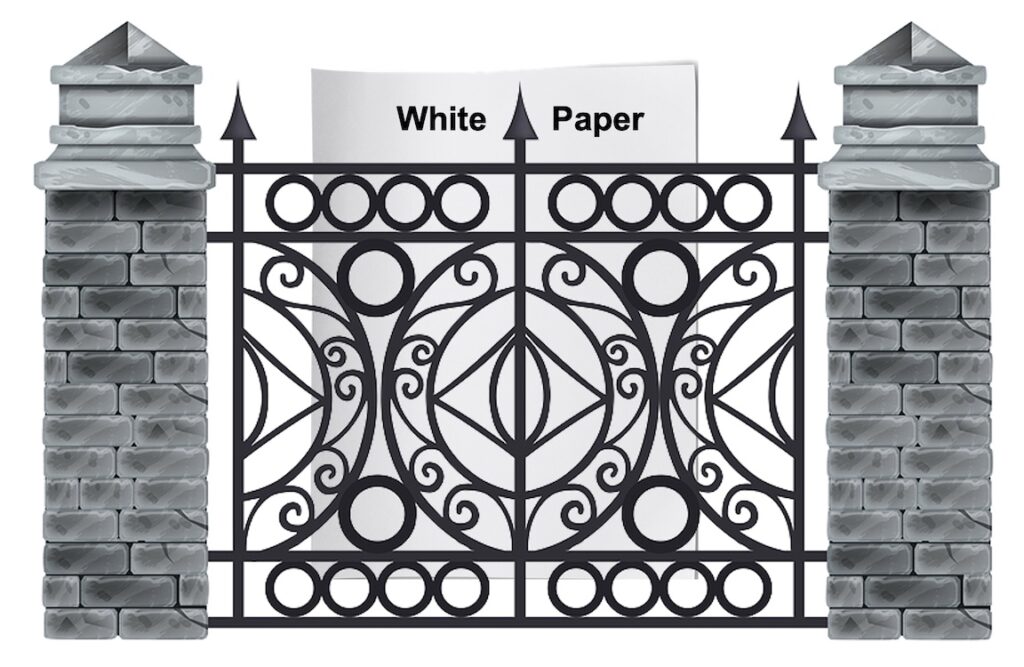
To gate or not to gate?
That is the question, for anyone involved in content marketing today.
So what’s the best answer?
As you know, “gated content” is a white paper, special report, or any other content you give to a site visitor after they complete a registration form.
We’ve all filled in those forms. But do they work?
Here’s a dirty little secret of content marketing
Not everyone tells the truth on registration forms.
For example, one survey done by MarketingSherpa found that about 7 out of 10 prospects give their true name.
But less than 6 out of 10 give their real industry, company name, or job title. And less than 4 out of 10 give their actual phone number.
I’ve filled in some forms with names like “Donald Duck” and phone numbers like “123-456-7890.” Haven’t you?
Especially when the form is way too long.
Beyond that, many business people have a free e-mail account at Yahoo or Google to use only for content downloads. The rest of the time, they ignore those accounts.
Despite these issues, most B2B vendors used to routinely hide their white papers behind gates.
20X to 50X more downloads?!
At least they did until 2009. That’s when marketing guru and author David Meerman Scott made quite the splash.
He claimed that a white paper or e-book would be downloaded 20 to 50 times more often if there was no gate in front of it.
Consider what this means for lead generation, as shown in the following table.
| Ungated | Gated | Ratio | |
|---|---|---|---|
| How many visitors to landing page? | 120 | 120 | 1:1 |
| How many downloads? | 60 | 12 | 5:1 |
| How many reads? | 30 | 6 | 5:1 |
| How many pass-alongs? | 15 | 3 | 5:1 |
| Prospects reached | 45 | 9 | 5:1 |
This table uses relatively conservative assumptions:
- Ungated content is downloaded 5X as often
- Half those who download content read it
- Half of those who read content pass it along
Of course, your numbers may vary.
But if you’re in a position to do some testing and capture these metrics for your content campaigns, why not give it a try?
Then you can see for yourself what difference it makes to gate or not to gate.
What do you want to accomplish?
The problem with most discussions about gating is that they don’t start at square one: your purpose for creating content in the first place.
There are two main purposes for creating content:
- To generate leads
- To get noticed
This is where the discussion should start at your organization. Depending on your goals, you can quickly decide whether to gate your content or not.
1. Trying to generate leads?
If you want to generate leads and develop prospects, you’re going to need contact info to stay in touch.
So for generating leads, you need a registration form.
I’ve said it before: Keep the form simple. Maybe four fields in all: name, work e-mail, company, and title. And be thankful if you get honest answers to all four!
2. Trying to get noticed?
If you want to get your company noticed, you want as many people as possible to read and share your work. So take down that gate!
This is especially true for startups, and for any B2B firm waging a marketing campaign against an entrenched incumbent.
After all, they’re probably already on the shortlist of vendors to check out. Your goal is to get your firm noticed, so it’s in the running too.
Remember what makes content valuable
The most valuable B2B content helps a business person understand an issue, solve a problem, or make a decision.
If your content consistently does that, prospects won’t mind giving you some contact information.
When you give a business person something valuable, they know you’re going to try to develop them as customers by sending them more e-mails.
And they’re ready for that.
So don’t be too shy to ask.
For more on this issue, see our article “Gating: the third option.”
What works best for your company: gated or ungated content? Share your thoughts in the Comments section.
Want to hear whenever there’s a fresh article on this site? Subscribe here to stay in the know on long-form content. From time to time, we’ll also send you word about some great new resource or training. And you can unsubscribe any time.





As a CIO, I almost always give bogus contact information when I fill out one of those gate forms. I learned early on what happens when you tell the truth. You get flooded with calls from people who can barely speak English asking you to attend their webinar or worse – reading you a list of mutiple choice questions to qualify you.
Rrrrrring…
Me: “Eric Lynch, speaking”
Caller: “eh-lo, Edeek, this is Srinivas fdom ABC123 Company. How you doeeng to-deh?”
Me: Click
Great post, Gordon! The decision to gate or not to gate seems to not be a decision at all in many cases. In other words, it seems the default is often “we worked hard on this paper and we sure aren’t going to just give it away for free!” In other words, some companies think the value of the paper is tied to their effort to produce it.
I like your suggestion to start by determining your goal (leads or awareness). And I’d take it a step further and suggest B2B marketers need to map their white papers to the buying cycle. Prospective buyers early in the cycle are less likely to exchange their info for a download. Why reduce the number of potential buyers so early on? Have a bit of patience and deliver enough valuable content and prospects are usually willing to share their info.
Hey Gordon;
This topic is perfectly timed; I’ve been wrestling with the “gate/no gate” question for a bit. As of this post, I have decided on the following:
I propose–and employ–an “end gate philosophy” in the following manner;
1) Start (TOFU) Gate-Free to Get Noticed
All of my online content is gate free, with one exception, noted below.
The reason?
Throughput from source (me) to a prospective client is direct, simple, and anonymously accessible. In theory (and the data supports this), more people are going to initially read–and disseminate–my material. In short, “free” stuff supports further engagement.
Ideally, they will effortlessly drift farther down the gate-free funnel, leading to 2)…
2) Gate “Valid” Prospects for Lead-Gen
My rates are accessible only through a gate. Simply put, if someone has reviewed my un-gated material, and is interested enough to find out how much I cost, then they’re probably in need of my services. At this point, I want to know their email address and make them my newest pals.
This potentially saves substantial time pursuing “lookie-loo’s” that may pass through an earlier “top-of-funnel” gate.
As you mentioned Gordon, with content you’ve given a prospect something valuable and–at that point–they can expect to provide contact information. I think this “one-two” combination may work in concert with that notion.
Keep in mind however, this is only a personal theory. It could crash and burn.
Thanks again for the insightful article!
Dan
Very interesting and relevant information. Thank you for sharing!
If you are not going to gate, make strong calls to action in the content you’re giving away. If you are going to gate, try progressive profiling (available through good marketing automation tools, like Net-Results), where you start with a very simple gate (First Name and Email or just Email, even). Every time someone re-visits your site to get new content that has previously opted-in will have 1 or 2 basic questions to answer that vary from previously completed form fills. This way you are building a prospects profile to help figure out who they are and how you can best help them.
Great points for making the content gate-free, thanks Gordon. We’re just starting out with whitepapers and the gate/no gate dilemma has already generated quite a few questions, including the placement in the funnel that Dan has already mentioned.
If it came to forms, I would vote for the minimalistic name and email version, with a company address (an exlusion of Gmail and co.) And, of course, testing, testing, and testing.